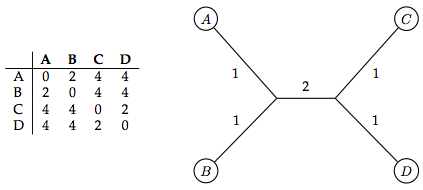Distance-based phylogeny aims to form an evolutionary tree on a collection of taxa by using a function that quantifies a distance measure between pairs of taxa. For example, if our taxa are represented by genetic strings, then Hamming or edit distance may be applied.
Once a particular metric has been selected, the distances between pairs of taxa are
consolidated into a distance matrix
For example, the figure below shows a consistent distance matrix on four taxa along with an unrooted binary tree modeling this distance matrix.
